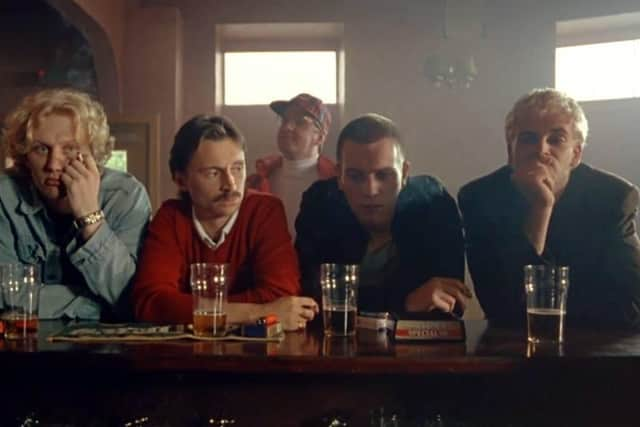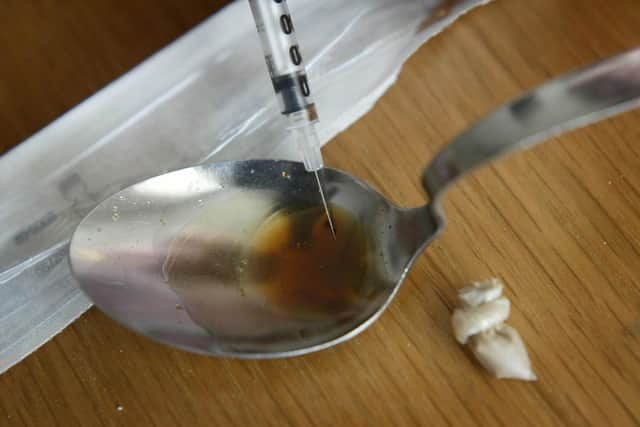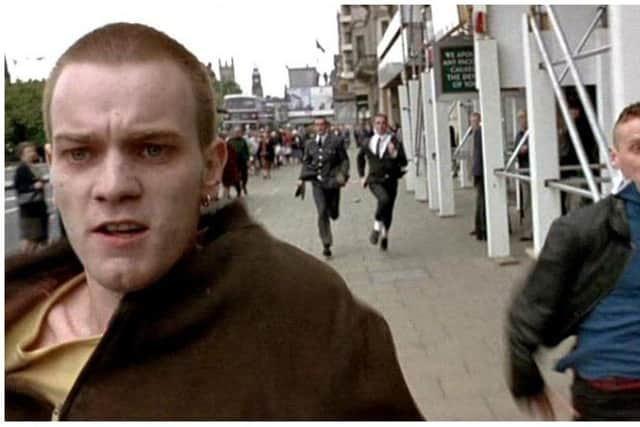Scotland drug deaths crisis: New drug trends define Scotland's second 'Trainspotting generation'
It has been nearly 30 years since Ewan McGregor and Ewen Bremner sprinted down Princes Street, hastened by two pursuing security guards and Iggy Pop’s “Lust For Life”, and bang on three decades since Irvine Welsh’s Trainspotting novel thrust heroin into the UK’s cultural zeitgeist.
Both the novel and the film captured the claustrophobic hopelessness of working class communities as heroin and the AIDs epidemic swept through Scotland in the 1980s.
Advertisement
Hide AdAdvertisement
Hide AdAccording to a November 2020 article in the British scientific journal The Lancet: “In the wake of the 1979 Iranian Revolution and the Soviet invasion of Afghanistan, cheap heroin flooded into Europe.


“In the mid-1970s, there were fewer than 100 injecting drug users in Edinburgh; by the early 1980s, there were more than 5000.”
Similar to today, police in 1980s Scotland could not stop the drug trade. Back then, however, police aggressively targeted drug paraphernalia – needles. Unlike in Glasgow, which introduced needle exchanges, this led to the widespread sharing of needles in Edinburgh. There were reports of single needles being shared between entire streets in the capital.
This led to an explosion in HIV, at a time where retroviral drugs were not yet sophisticated enough to prevent AIDs. Young, otherwise healthy heroin users in the city became ill, and soon began dying. The deaths were treated as purely drug deaths.
A blood test for HIV, previously thought to be a disease which only affected gay people, soon shone light on the cause of the deaths. It was actually a GP from Edinburgh’s Muirhouse area, Dr Roy Robertson, who made the connection by testing blood samples given by drug addicts during a hepatitis C outbreak.


More than 50 per cent of Edinburgh’s addicts turned out to be infected with the virus, making it the capital of Europe’s AIDs crisis – a statistic eerily similar to Scotland’s current status as Europe’s drug death capital.
The legacy of this period lingers in the minds of Scots who experienced it, and can still prejudice views of the current drug deaths crisis.
While there are similarities – both crises have appeared against a backdrop of widening wealth inequality and austerity – modern patterns of drug use appear to differ substantially from the Trainspotting generation.
Advertisement
Hide AdAdvertisement
Hide AdPublic Health Scotland’s Rapid Action Drug Alerts and Response (RADAR) unit provides a fascinating snapshot of current drug trends, as does the National Records of Scotland’s (NRS) drug death statistics.


In 2022, NRS recorded 1,051 “drugs misuse” deaths in Scotland. These figures do not provide a full picture, however, due to how the organisation gathers and presents the data.
Scotland’s drug deaths data excludes secondary infections, such as bacterial or viral infections, resulting from the injection of contaminated drugs. This would exclude deaths caused by clostridium, hepatitis and HIV/AIDs where drug use led to infection.
Scotland also excludes conditions “which could be regarded as later complications of drug use”, meaning deaths caused by the long term consequences of drug abuse – such as heart or liver failure – are not recorded as drug deaths.
This includes: “bronchopneumonia, lobar pneumonia, bilateral pneumonia, septicaemia or organ failure where drug misuse was not specified as the direct and immediate cause of death”.
Between 2011 and 2021, the National Records of Scotland (NRS) excluded an average of 24.4 “secondary” drug deaths from the official statistics. Last year, when figures saw a 20 per cent drop in drug deaths, NRS excluded 43 – nearly double the annual average.
A spokesperson for the NRS told Scotland on Sunday that this policy has been in place “since the series began”.
In contrast to the 1980s and 1990s, however, the number of HIV/AIDs deaths among Scotland’s drug users is actually quite small.
Advertisement
Hide AdAdvertisement
Hide AdLast year, the NRS recorded just eight deaths caused by HIV/AIDs associated with drug use, and 15 deaths caused by hepatitis-C. These deaths are excluded from its drug death data as secondary causes of death.
There are several reasons for the massive reduction in AIDs deaths among drug users in Scotland. Primarily, needle exchange clinics have become the norm, and – crucially – accepted by the authorities. While accepted in Glasgow in the 1980s, police in Edinburgh contributed to the AIDs epidemic by harassing needle exchange users and executing arrest warrants for people using the clinics.
A similar battle is currently taking place in Glasgow, where Peter Krykant, a former drug user and activist, has been operating an unsanctioned “safe consumption van” in an effort to curb drug deaths in the city. Mr Krykant’s van has been shown to save lives by an academic paper investigating its effectiveness, but police officers did charge him on one occasion, before the procurator fiscal opted to take no action.
Secondly, antiretroviral drugs are now sophisticated enough to prevent HIV from developing into AIDs for decades. The average life expectancy for a person being fully compliant with HIV treatment is now thought to be similar to an uninfected person.
Finally, the nature of drug use has changed.
RADAR’s ‘Surveillance Study in Illicit Substance Toxicity’ (ASSIST), tested 100 emergency drug attendances at Glasgow’s Queen Elizabeth University Hospital between February and May 2023.
The ASSIST study found the most commonly detected individual drug was cocaine, present in 49 per cent of the samples taken.
However, the study has shown a trend towards poly-drug use, with many patients having more than one drug present in their system. The most popular type of drug to pair with other substances is benzodiazepines, such as diazepam and illicit “street” versions such as etizolam. Benzodiazepines made up 51 per cent of all drug detections in the study.
This type of drug, which can reduce anxiety and curb withdrawal symptoms from other drugs such as opiates and cocaine, can be bought online or on the street for as little as £1 a pill. It is a depressant – meaning it suppresses central nervous system functions such as breathing – and its effects and toxicity are multiplied when it is used in conjunction with other depressants such as alcohol or opiates.
Advertisement
Hide AdAdvertisement
Hide AdThere are still opiate users, but there has been a shift away from intravenous drugs. Morphine, a metabolite of heroin, was detected 25 times, while codeine and methadone, which are taken orally, were detected 17 and 15 times respectively. This is likely due to a combination of the stigma surrounding intravenous drugs, even among drug users, and the harsh fact that many of Scotland’s intravenous drug users have already died.
Although heroin is accounting for fewer hospitalisations than it used to, opiates are still being detected in the majority of drug deaths, particularly when used in conjunction with benzodiazepines.
Between October 1 and December 31 in 2022, the total number of deaths testing positive for controlled substances was 478, according to RADAR.
Of those deaths, heroin was detected in 187 – the most common single drug. Opiates as a whole were implicated in 358 deaths (75 per cent) while benzodiazepines were detected in 296 deaths (62 per cent). Given both drugs were detected in a large majority of drug deaths, it can be inferred they are frequently found in the same poly-drug overdoses.
Concerns regarding poly-drug use now account for more than half of the reports submitted to RADAR.
The demographics are changing, too. Scotland’s Trainspotting generation was categorised by youth, but over half of the suspected drug presentations at QEUH’s emergency department during the ASSIST study were over 35 years old, with 29 per cent aged 35 to 44 years.
There are still changes to come in Scotland’s drug trends, particularly a move towards synthetic drugs made in laboratories, not grown in poppy or coca fields. Nearly a third of reports to RADAR relate to drugs being contaminated, “laced” or stronger than expected.
Nitazenes, a type of synthetic opioid several hundred times more potent than heroin and 20 times more potent than other synthetic opioids like fentanyl, has been found being mis-sold as oxycodone in Scotland. It has already been detected in drug deaths.
Advertisement
Hide AdAdvertisement
Hide AdBetween February 27 and May 28, the average number of incidents a week where Scottish Ambulance Service workers have to administer naloxone, which treats opioid overdoses was 75.
Benzodiazepines are changing, too. Between 2016 and 2022, etizolam was the primary drug detected in street benzodiazepines (benzos) in Scotland.
According to PHS, “data shows the market is significantly changing, etizolam detections are decreasing and detections of new benzodiazepines are increasing”.
In July, RADAR issued an alert regarding bromazolam, a new street benzo. It has already taken lives in Scotland, and “detections have increased rapidly in the last year”. It was present in 37 per cent of the samples in the ASSIST study mentioned above.
In Danny Boyle’s 2017 sequel, Trainspotting 2, Ewan McGregor’s Renton riffs on his classic ‘Choose Life’ monologue from the original, this time including: “Sit back and smother the pain with an unknown dose of an unknown drug made in somebody's f***ing kitchen”.
In Scotland’s second Trainspotting generation, 23 people die each week. More than a hundred a month. More than 1,000 a year.
Comments
Want to join the conversation? Please or to comment on this article.